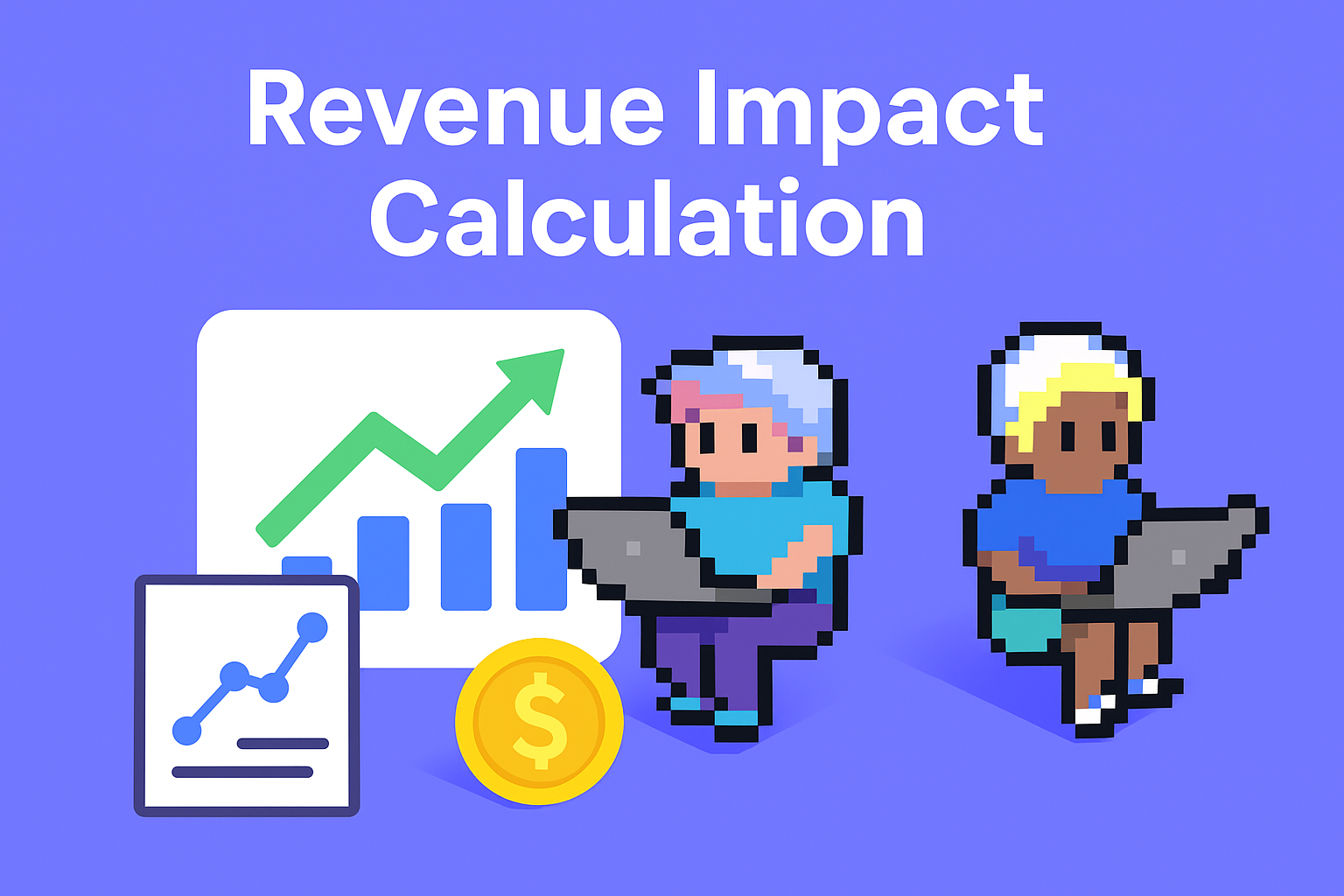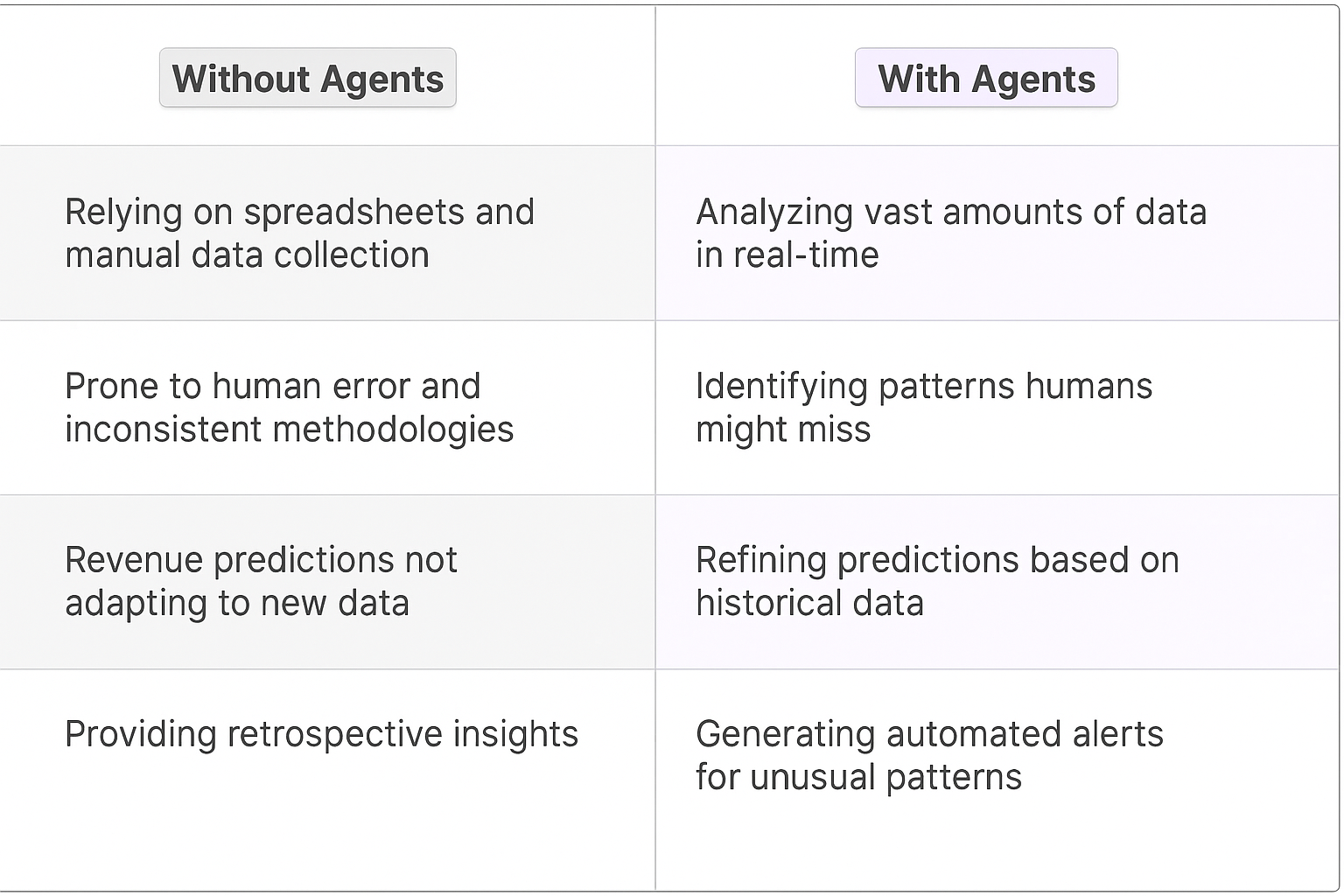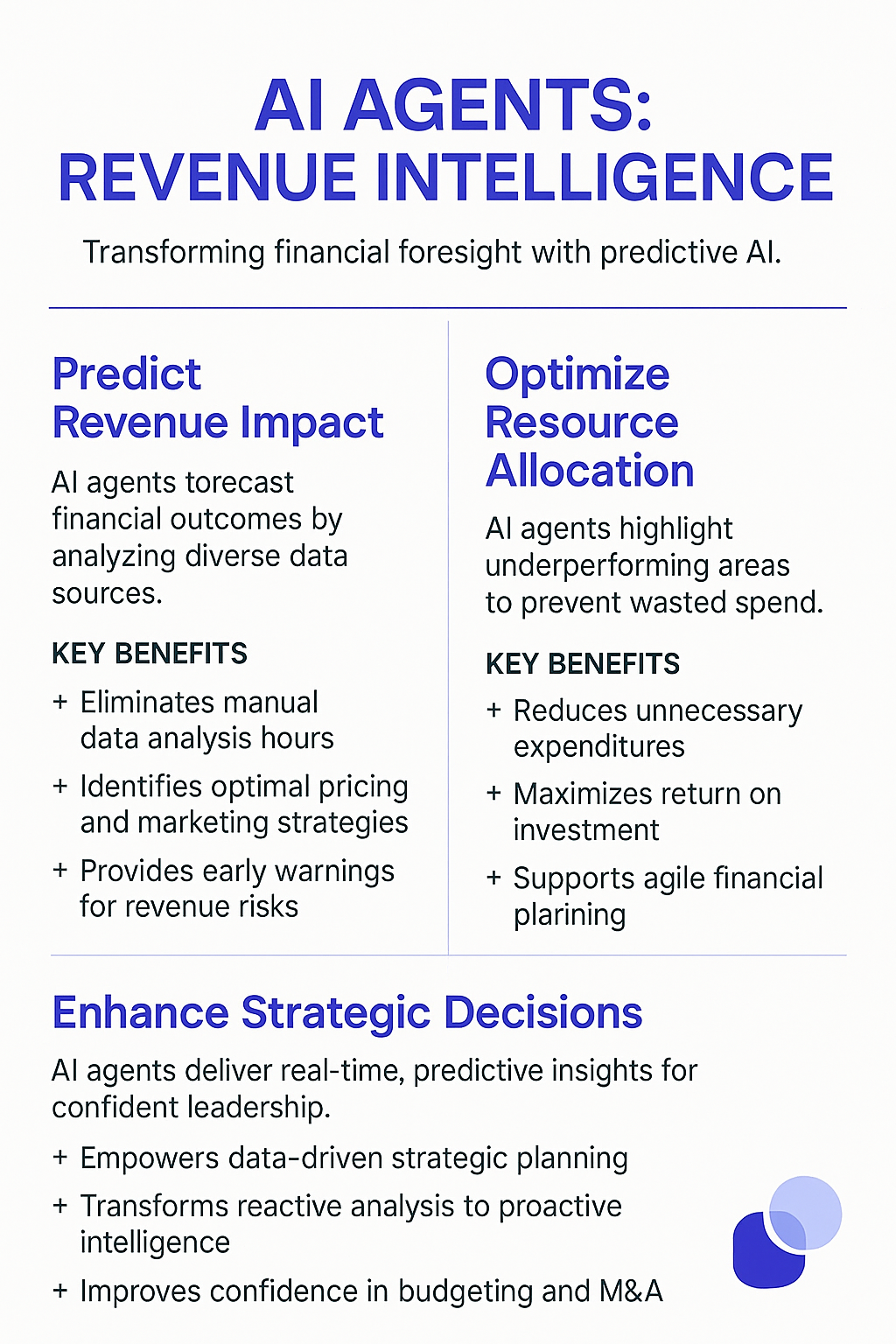Revenue Impact Calculation AI Agents
Understanding Revenue Impact Calculation in Modern Business
What is Revenue Impact Calculation?
Revenue Impact Calculation is a sophisticated financial analysis process that measures and predicts how different business decisions, market conditions, and customer behaviors affect a company's income streams. When powered by AI Agents, this process moves beyond static spreadsheets into dynamic, real-time analysis that captures complex revenue patterns and relationships across multiple variables.
Key Features of Revenue Impact Calculation
- Real-time data processing from multiple revenue sources
- Pattern recognition across customer segments and time periods
- Predictive modeling for future revenue scenarios
- Automated anomaly detection in revenue streams
- Dynamic adjustment of calculations based on new data
- Multi-variable analysis of revenue drivers

Benefits of AI Agents for Revenue Impact Calculation
What would have been used before AI Agents?
Traditional revenue impact calculations relied heavily on manual spreadsheet work, with finance teams spending countless hours piecing together data from multiple sources. They'd pull numbers from CRM systems, accounting software, and various departmental reports, then attempt to create coherent forecasts. The process was prone to human error, inconsistent methodologies across teams, and significant time lags between data collection and actionable insights.
Most companies used a combination of Excel macros, basic BI tools, and periodic manual reviews. This meant revenue insights were often retrospective rather than predictive, and teams struggled to factor in complex variables like seasonal trends, market conditions, and customer behavior patterns.
What are the benefits of AI Agents?
AI Agents transform revenue impact calculation through their ability to process vast amounts of data in real-time while identifying patterns humans might miss. These digital teammates can simultaneously analyze customer purchase history, market trends, and competitive dynamics to generate accurate revenue predictions.
The real game-changer is their ability to learn from historical data and adapt their models. When a revenue prediction misses the mark, AI Agents automatically refine their approach for future calculations. They're particularly effective at:
- Detecting subtle revenue patterns across different customer segments
- Calculating the compound effects of multiple business decisions on revenue
- Providing instant scenario analysis for different pricing strategies
- Identifying revenue leakage points in real-time
- Generating automated alerts for unusual revenue patterns
Beyond pure calculation, these AI Agents serve as proactive financial advisors, flagging potential revenue risks and opportunities before they become apparent in traditional reporting cycles. They're particularly valuable for businesses with complex revenue streams, subscription models, or seasonal fluctuations.
The shift from reactive to predictive revenue management represents a fundamental evolution in how businesses understand and optimize their income streams. Teams can now focus on strategic decision-making rather than getting lost in spreadsheet cells.
Potential Use Cases of Revenue Impact Calculation AI Agents
Processes
- Analyzing historical revenue data to identify growth patterns and revenue drivers
- Calculating customer lifetime value across different segments
- Modeling pricing strategy impacts on revenue forecasts
- Evaluating sales team performance and territory optimization
- Measuring marketing campaign ROI and revenue attribution
Tasks
- Running what-if scenarios for different pricing models
- Generating revenue forecasts based on multiple variables
- Calculating churn impact on monthly recurring revenue
- Analyzing seasonal revenue patterns
- Identifying revenue leakage points in the sales process
The Growth Loop Perspective
Revenue impact calculation is fundamentally about understanding the mechanics of your growth engine. When we look at companies like Uber or Airbnb, their early growth came from deeply understanding their unit economics and revenue drivers. A Revenue Impact Calculation AI agent functions as your dedicated growth mathematician, processing complex scenarios that would take hours to model in spreadsheets.
The real power comes from combining granular transaction data with market dynamics. For example, a B2B SaaS company can use these digital teammates to model how changes in their land-and-expand strategy affect net revenue retention. They can simulate thousands of customer journeys, accounting for variables like team size, industry, and usage patterns.
What's particularly interesting is how these agents can identify non-obvious revenue opportunities. They might discover that customers who engage with certain product features in their first 30 days have a 40% higher lifetime value, or that specific combinations of pricing tiers drive better expansion revenue.
Implementation Strategy
The key to successful implementation is starting with clear revenue hypotheses. Rather than trying to boil the ocean, focus on one critical revenue question at a time. For instance, begin with understanding the revenue impact of your customer acquisition cost in different channels, then expand to more complex analyses like multi-year forecasting.
Connect your revenue impact calculation agent to your core systems - CRM, billing, product analytics. This creates a closed loop where the agent continuously learns from actual results and refines its models. The goal isn't to replace human judgment but to augment it with data-driven insights that would be impossible to generate manually.
Measuring Success
Track the accuracy of revenue predictions over time. Compare the agent's forecasts against actual results and measure the delta. The real value shows up in better decision-making - more accurate budgeting, optimized pricing strategies, and improved resource allocation across growth initiatives.
The most successful teams use these agents as part of their weekly revenue operations rhythm. They're not just forecasting tools but active participants in revenue strategy discussions, providing real-time impact analysis of potential decisions.

Industry Use Cases
Revenue impact calculation AI agents are fundamentally changing how businesses understand and predict their financial outcomes. Drawing from my experience working with hundreds of growth-stage companies, I've observed that the real power lies in how these digital teammates handle the complex interplay of variables that influence revenue.
The most compelling aspect is how these AI agents can process vast datasets spanning customer behavior, market conditions, and internal metrics - tasks that would take human analysts weeks to complete. They're particularly effective at identifying non-obvious correlations and patterns that traditional analytics often miss.
What makes this technology particularly fascinating is its ability to adapt and learn from industry-specific nuances. Whether you're running a SaaS business with recurring revenue models or managing a retail operation with seasonal fluctuations, these AI agents can calibrate their calculations to match your business context.
The real game-changer isn't just the speed of calculations - it's the depth of insight. These digital teammates can simultaneously analyze multiple revenue scenarios, factor in market variables, and provide probability-weighted outcomes that help teams make more informed decisions about resource allocation and growth strategies.
E-commerce Revenue Analysis: Beyond Basic Metrics
When I worked with growth teams at Uber, one of our biggest challenges was understanding the true revenue impact of product changes across our complex marketplace. This same challenge exists in e-commerce, where Revenue Impact Calculation AI agents are transforming how online retailers measure success.
A major online fashion retailer implemented a Revenue Impact Calculation AI agent to analyze their product recommendation engine. Traditional analytics might show that recommendations drove 25% of purchases, but this oversimplifies a complex customer journey. The AI agent dug deeper, examining:
- Cross-category purchase patterns
- Time decay between recommendation exposure and purchase
- Cannibalization effects on other product views
- Price point influences on conversion
- Customer segment variations
The analysis revealed that while recommendations influenced $50M in direct revenue, they actually generated $78M in total revenue when accounting for downstream purchases and customer lifetime value changes. However, they also cannibalized $12M from organic category browsing, resulting in a net revenue impact of $66M.
This granular understanding led to specific optimizations: showing higher-margin items earlier in recommendation sequences, adjusting the mix of new vs. familiar brands, and personalizing recommendation timing based on customer purchase cycles. The result was a 31% increase in recommendation-driven revenue over 6 months.
The key insight isn't just the more accurate revenue attribution - it's how AI agents can process thousands of interconnected variables to reveal revenue impacts that would be impossible to calculate manually. This moves us from "did this feature work?" to "how exactly did it work, and how can we make it work better?"
SaaS Revenue Attribution: The Hidden Growth Levers
During my time advising B2B SaaS companies, I've noticed a persistent blind spot in how they measure revenue impact across their complex sales motions. Revenue Impact Calculation AI agents are now filling this gap with unprecedented precision.
A mid-market CRM platform deployed a Revenue Impact Calculation AI agent to decode their multi-touch sales process. The conventional attribution model credited their webinars with 15% of closed deals, but this missed crucial nuances. The AI agent analyzed:
- Content engagement sequences leading to sales calls
- Feature usage patterns of successful vs. churned customers
- Sales team interaction timing effects
- Contract value correlations with onboarding paths
- Product-led growth conversion patterns
The findings challenged their core assumptions: while webinars influenced $2.4M in attributed pipeline, the true impact reached $4.1M when including delayed conversions and expansion revenue. However, the analysis also showed webinars were pulling resources from higher-converting bottom-funnel activities, reducing potential revenue by $800K annually.
Armed with this intelligence, the CRM company rebuilt their revenue engine: they shifted webinar content toward specific industry use cases, integrated product demos earlier in the customer journey, and created automated follow-up sequences based on engagement signals. Within two quarters, their sales cycle shortened by 22% and average contract value increased by 37%.
The real power lies in how AI agents can map the network effects of revenue-generating activities. Instead of isolated metrics, we get a dynamic model of how different touchpoints interact and compound over time. This shifts the conversation from basic attribution to understanding the full revenue ecosystem.

Considerations for Revenue Impact AI Implementation
Building a revenue impact calculation system with AI requires careful navigation of multiple interconnected challenges. The complexity goes far beyond simple number crunching - we're dealing with intricate data relationships that directly affect business decisions.
Technical Challenges
Data quality stands as the primary technical hurdle. Revenue calculations demand pristine data from multiple sources - CRM systems, payment processors, accounting software, and customer usage metrics. The AI needs to handle missing datapoints, inconsistent formats, and temporal misalignments between these sources.
Model accuracy presents another significant challenge. The AI must account for complex revenue patterns like seasonal fluctuations, multi-year contracts, and varying payment terms. False positives in revenue prediction can lead to misguided business strategies, while false negatives might cause missed opportunities.
Operational Challenges
Cross-functional alignment becomes critical when implementing revenue impact AI. Sales teams need to trust the predictions, finance teams must validate the calculations, and product teams should understand how feature usage ties to revenue metrics. Without this alignment, the AI's insights may go unused or be misinterpreted.
Change management requires careful handling. Teams often have established ways of calculating revenue impact. Transitioning to AI-driven calculations means retraining staff, updating processes, and potentially modifying compensation structures tied to revenue metrics.
Integration Requirements
The AI system needs seamless integration with existing financial tools and workflows. This includes real-time data synchronization, audit trail maintenance, and compliance with financial reporting standards. Custom APIs and data pipelines often need development to ensure smooth data flow.
Security protocols must be robust given the sensitive nature of revenue data. The AI system requires encryption, access controls, and regular security audits while maintaining the speed and accessibility needed for daily operations.
Scaling Considerations
As transaction volumes grow, the AI must maintain accuracy and speed. This means building flexible architecture that can handle increasing data loads without degrading performance. The system should also adapt to new revenue streams and business models without requiring major overhauls.
Cost management becomes crucial at scale. Processing power, storage requirements, and API calls can drive up operational expenses. Finding the right balance between computational depth and resource efficiency helps maintain ROI as the system grows.
AI-Driven Financial Analysis: The Future of Business Intelligence
The adoption of AI Agents for revenue impact calculation marks a fundamental shift in financial analysis and business intelligence. These digital teammates don't just crunch numbers faster - they uncover hidden revenue patterns, predict future outcomes, and provide strategic insights that drive better business decisions. As companies continue to generate more complex revenue streams, the role of AI in financial analysis will only grow more crucial. The winners in this space will be those who effectively combine AI capabilities with human strategic thinking to build more resilient and profitable businesses.











